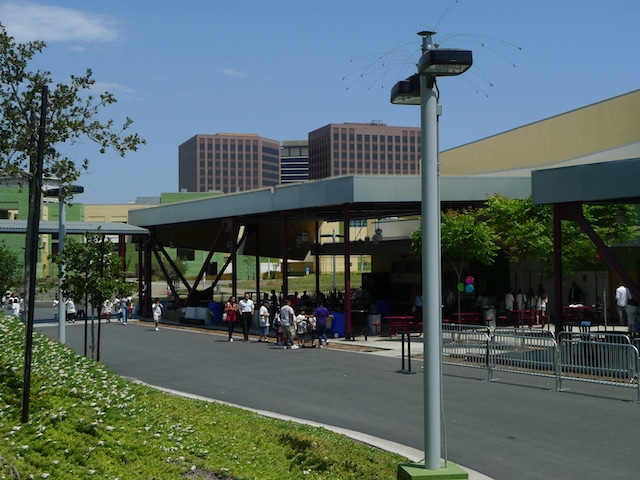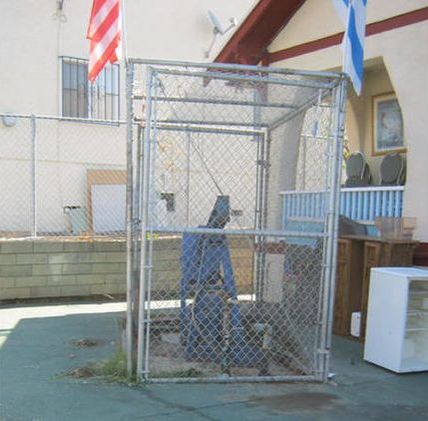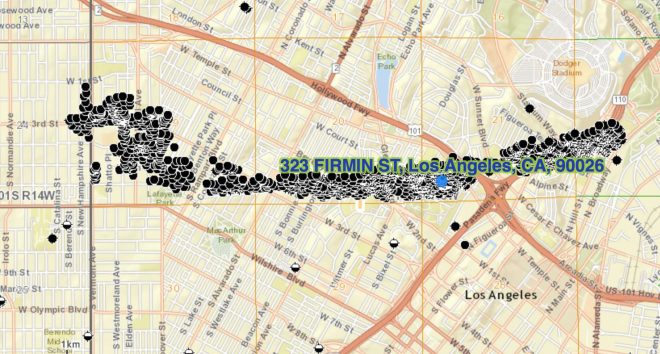ECHO PARK WELLS
Thousands of Angelenos in Echo Park, Westlake, and Koreatown live, learn, and work on top of aging and abandoned wells. These wells threaten their health, and remediating improperly plugged wells have cost tax-payers hundreds of thousands of dollars.
 A methane gas vent disguised as a lamp post at the Edward Roybal Learning Center (via the Nile Guide)
A methane gas vent disguised as a lamp post at the Edward Roybal Learning Center (via the Nile Guide)
Edward Roybal Learning Center (formerly the Belmont Learning Center): 1200 Colton St., Los Angeles, CA
Los Angeles’ love affair with oil began just half a mile away from Edward Roybal Learning Center. In 1892, infamous oil tycoon, Edward Doheny, dug the first successful oil well in Los Angeles, underneath what is now the Echo Park Pool parking lot. It set off an oil drilling frenzy, and over the next 20 years, wildcatters proceeded to dig over a thousand wells along a four mile stretch west of downtown.
Now, almost 130 years later, all but one have been abandoned. Most of the wells were plugged prior to the 1950’s, before California created regulatory agencies or guidelines on proper well abandonment. Oil well operators would plug the holes with whatever was lying around, from rocks, debris, and even telephone poles.
The haphazard burial of these wells was partly why it cost over $400 million and two decades to build the Roybal Learning Center. The high school is in an explosive methane zone, atop the old oil field’s center of operations. Not only does the school itself sit on of 19 abandoned wells, it is surrounded by hundreds of old wells buried beneath nearby homes, parks, and an elementary school.
In order to protect its 2,500 students from potential disaster, the Learning Center was forced to install a $17 million methane detection and air ventilation system. Despite its staggering price tag, foul, the system failed to prevent a pungent, gas-like odor that caused a partial evacuation of the school in 2013, and nausea and headaches amongst teachers.
Los Angeles’ love affair with oil began just half a mile away from Edward Roybal Learning Center. In 1892, infamous oil tycoon, Edward Doheny, dug the first successful oil well in Los Angeles, underneath what is now the Echo Park Pool parking lot. It set off an oil drilling frenzy, and over the next 20 years, wildcatters proceeded to dig over a thousand wells along a four mile stretch west of downtown.
Now, almost 130 years later, all but one have been abandoned. Most of the wells were plugged prior to the 1950’s, before California created regulatory agencies or guidelines on proper well abandonment. Oil well operators would plug the holes with whatever was lying around, from rocks, debris, and even telephone poles.
The haphazard burial of these wells was partly why it cost over $400 million and two decades to build the Roybal Learning Center. The high school is in an explosive methane zone, atop the old oil field’s center of operations. Not only does the school itself sit on of 19 abandoned wells, it is surrounded by hundreds of old wells buried beneath nearby homes, parks, and an elementary school.
In order to protect its 2,500 students from potential disaster, the Learning Center was forced to install a $17 million methane detection and air ventilation system. Despite its staggering price tag, foul, the system failed to prevent a pungent, gas-like odor that caused a partial evacuation of the school in 2013, and nausea and headaches amongst teachers.
If you believe that you have an old oil or gas well on your property, email the California Department of Conservation at [email protected] to request an investigation.
 An oil well in the front yard of a Firmin Street house. (DOGGR)
An oil well in the front yard of a Firmin Street house. (DOGGR)
Firmin Wells: 323 and 324 Firmin Street.
Although the California Department of Conservation’s Division of Gas and Geothermal Resources (DOGGR) has records of 1,250 wells buried and abandoned throughout this area, there could be hundreds more lurking beneath the surface of Echo Park. Because oil drilling in the early years of Los Angeles’ history predated any sort of regulatory agency, there are very few records about the location, let alone existence, of these ghost wells. A recent study suggests that there could be over 300 of these ghost wells that could have been drilled and then abandoned without a trace.
Residents of Firmin Street in Echo Park had an unfortunate first-hand experience with a ghost well. When one resident noticed a sulfur-like, rotten egg odor permeating the neighborhood, he dug up his front yard to investigate and found an abandoned oil well, just a few feet from his doorstep. When the South Coast Air Quality Management District began investigating the well, they found that the methane concentrations were well above acceptable flammability levels.
State officials tried to find the owner of the wells to remediate it. However, unable to locate the responsible party, the financial burden fell upon the tax payers and the state to plug the well to the tune of $360,000.
As Echo Park and Koreatown continue to develop aggressively for residential and commercial use, it is safe to assume that we will continue to unearth new ghost wells that are putting Angelenos at risk. Unless elected officials move to hold the oil industry accountable, taxpayers will continue to foot the bill for more than a century of reckless oil development in Los Angeles.
Although the California Department of Conservation’s Division of Gas and Geothermal Resources (DOGGR) has records of 1,250 wells buried and abandoned throughout this area, there could be hundreds more lurking beneath the surface of Echo Park. Because oil drilling in the early years of Los Angeles’ history predated any sort of regulatory agency, there are very few records about the location, let alone existence, of these ghost wells. A recent study suggests that there could be over 300 of these ghost wells that could have been drilled and then abandoned without a trace.
Residents of Firmin Street in Echo Park had an unfortunate first-hand experience with a ghost well. When one resident noticed a sulfur-like, rotten egg odor permeating the neighborhood, he dug up his front yard to investigate and found an abandoned oil well, just a few feet from his doorstep. When the South Coast Air Quality Management District began investigating the well, they found that the methane concentrations were well above acceptable flammability levels.
State officials tried to find the owner of the wells to remediate it. However, unable to locate the responsible party, the financial burden fell upon the tax payers and the state to plug the well to the tune of $360,000.
As Echo Park and Koreatown continue to develop aggressively for residential and commercial use, it is safe to assume that we will continue to unearth new ghost wells that are putting Angelenos at risk. Unless elected officials move to hold the oil industry accountable, taxpayers will continue to foot the bill for more than a century of reckless oil development in Los Angeles.
